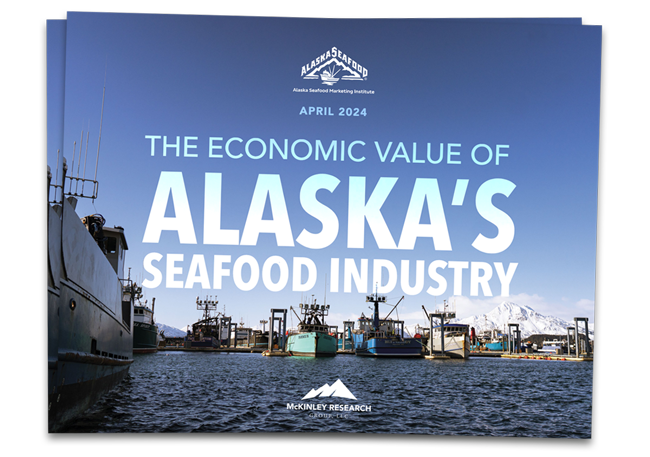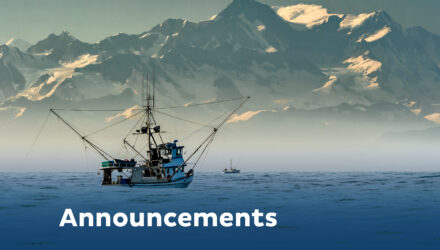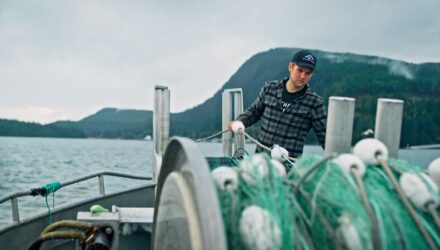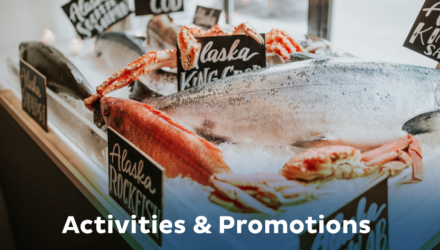FOR RELEASE: Updated Report Shows Seafood Industry Adds $6B to Alaska’s Economy


Contact:
Greg Smith, Alaska Seafood Marketing Institute
(907) 465-5562, [email protected]
FOR IMMEDIATE RELEASE
Economic Value Reports Shows Alaska Seafood Industry Responsible for Employing Over 48,000 Workers, $2.3 Billion in Labor Income, and $6 Billion in Economic Impact in Alaska
JUNEAU, Alaska. April 24, 2024 -The 2024 update of The Economic Value of Alaska’s Seafood Industry report illustrates the critical role Alaska’s seafood industry plays in the state’s economy. The seafood industry directly employs more than 48,000 workers annually in Alaska and contributes $6 billion to Alaska’s economy.
“Alaska’s seafood industry is a critical pillar of Alaska’s economy,” said Alaska Seafood Marketing Institute (ASMI) Executive Director Jeremy Woodrow. “The economic benefits of the seafood industry are felt by all Alaskans.”
The report demonstrates that seafood continues to play a critical role in delivering value for Alaskans:
- The Alaska seafood industry harvested 5.8 billion pounds of seafood, worth $2.0 billion, in 2022.
- Processors turned this harvest into 2.3 billion pounds of product worth $5.2 billion, adding $3.2 billion in value.
- Seafood processing is the largest manufacturing sector in Alaska, accounting for 66% of the state’s manufacturing employment in 2022.
- The seafood industry directly employed 48,000 workers in Alaska, including 17,000 Alaskans from more than 142 communities, annually in 2021/2022.
- Total Alaska labor income was $2.3 billion, including multiplier effects.
The seafood industry further helps anchor Alaska’s economy by contributing to the economic stability of support industries statewide and rural communities:
- In 2022, 53% of the industry’s skippers, active permit owners, and crew were Alaska residents, a total of about 13,000 fishermen.
- The industry paid more than $161 million in taxes (most to state and local governments), fees, and self-assessments in 2022. The seafood industry was the largest source of municipal tax revenue for 11 municipal governments in 2022.
- For many rural Alaska communities, the seafood industry is among the largest sources of employment, wages, and tax revenue.
Alaska’s seafood industry contributes to the global seafood supply and is also a vital source of economic activity for the nation:
- Alaska harvest is about 60% of the total United States seafood harvest, more wild-caught seafood than all other states combined, and 1.3% of the global seafood harvest (including wild capture and aquaculture).
- Alaska seafood contributes $15.8 billion to the U.S. economy and creates 81,100 full time equivalent jobs nationally.
Despite the strength of these numbers, which relies largely on data from 2022, present day global market pressures are having significant impacts on all Alaska fishermen, fishing families, and fishing businesses.
A combination of factors, from local to global, contributed to lower prices for many Alaska, U.S., and global seafood species in 2023:
- In 2023, lower consumer demand led to U.S. seafood retail sales volumes falling below pre-pandemic benchmarks, reversing substantial gains earned in 2020 and 2021; consumers cite cost concerns as a primary reason they have moved away from seafood.
- The U.S. dollar was strong in 2023 compared to currencies of key Alaska seafood importers (especially Japan), making Alaska seafood prices less competitive.
- Carryover of 2022 product inventory including sockeye salmon, white fish, and king crab from Russia made wholesale and retailers less motivated to buy 2023 products.
- Global harvest increased supply for many key Alaska seafood products such as Alaska pollock and pink salmon in 2023, including Alaska harvest and competing harvest from Russia.
Even with these challenges, Woodrow notes, the Alaska industry is strong.
“The brand of Alaska Seafood is cherished among consumers. The variety and superior quality of products Alaska has to offer is unmatched. Research shows that consumers strongly prefer wild seafood to farmed, they want to add more sustainable seafood to their routines, and they place a high value on the health benefits of seafood. Alaska has the most passionate fleet behind this industry and we will weather this storm together and come out stronger on the other side,” said Woodrow.
Originally published in 2013 and updated in 2015, 2017, 2020, 2022 and 2024, the Economic Value of Alaska’s Seafood Industry report is prepared by McKinley Research Group for ASMI. The report is available online at alaskaseafood.org. Printed copies are available upon request.
Read the report here.
###
About Alaska Seafood Marketing Institute:
The Alaska Seafood Marketing Institute (ASMI) is a partnership between the State of Alaska and the Alaska seafood industry promoting the benefits of wild and sustainable Alaska seafood and offering seafood industry education. The seafood industry is Alaska’s largest basic private sector employer with nearly 60% of all wild seafood and 90-95% of wild salmon harvested in the U.S. coming from Alaska. In addition to wild salmon, Alaska is known for its crab and whitefish varieties such as Pacific cod, sablefish, halibut, Alaska pollock, sole and rockfish – available fresh or frozen year-round. Alaska has been dedicated to sustainable seafood for more than 50 years and is the only state with a constitution that mandates all seafood be managed under the sustained yield principle. Alaska has taken a leadership role in setting the global standard for precautionary resource management to protect fisheries and surrounding habitats for future generations and leading to an ever-replenishing supply of wild seafood for markets worldwide.



